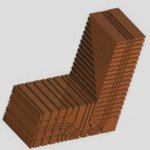
In a collaboration between the Institut für Quantenoptik (IQ) and the Institut for Fysik og Astronomi (IFA) our group contributes to the development of a novel mesoscopic atom chip. The experiment is located at the Leibniz Universität Hannover.
In the past, a broad field has been established using Bose-Einstein condensates as a versatile system to measure a multitude of quantum effects. The CHIP project aims to set up a new apparatus for creating Bose-Einstein condensates, providing higher repetition rates to overcome the limitations due to the slow cycle times of other BEC machines.
For this project current carrying planar wire structures were developed to generate the magnetic fields used for magneto optical cooling, magnetic trapping and the transport of ultracold 87Rb clouds. With this approach it will be possible to rapidly replenish BECs and to combine a chain of ultra cold clouds in one trap to obtain particularly large BECs.
More information on the IQ website.
We contributed to the detection and stabilization of single atoms in collaboration with the Quantum Atom Optics group at Hannover University.
In our joint work we present an accurate fluorescence detection technique for atoms that is fully integrated into an experimental apparatus for the production of entangled quantum states. Single-particle resolving fluorescence measurements for 1 up to 30 atoms are presented. We utilize the accurate atom number detection for a number stabilization of the laser-cooled atomic ensemble. For a target ensemble size of 7 atoms prepared on demand, we achieve a 92% preparation fidelity and reach number fluctuations 18dB below the shot noise level using real-time feedback on the magneto-optical trap.
See our publication on arXiv.
(12/2019)
Typical sources of ultracold atoms operate with a considerable delay between the delivery of ensembles due to sequential trapping and cooling schemes. Therefore, alternative schemes for the continuous generation of ultracold atoms are highly desirable. Here, we demonstrate the continuous loading of a magnetic trap from a quasi-continuous atom beam. We achieve a steady state with 3.8x107 magnetically trapped atoms and a temperature of 102uK. The ensemble is protected from laser light sources, a requirement for its application in metrological tasks or sympathetic cooling. The continuous scheme is robust and applicable to a wide range of particles and trapping potentials.
In addition, this work received media attention at 2physics and at Physicsworld.com. The paper can be found here. (07/2015)

Published in Applied Physics Letters!
In recent decades, cold atom experiments have become increasingly complex. While computers control most parameters, optimization is mostly done manually. This is a time-consuming task for a high-dimensional parameter space with unknown correlations. Here we automate this process using a genetic algorithm based on differential evolution. We demonstrate that this algorithm optimizes 21 correlated parameters and that it is robust against local maxima and experimental noise. The algorithm is flexible and easy to implement. Thus, the presented scheme can be applied to a wide range of experimental optimization tasks. Appl. Phys. Lett. 102, 214105 (05/13)

In a collaboration with the at the Institut für Quantenoptik, Leibniz Universität Hannover we realized a novel mesoscopic atom chip. Magneto-optical traps on atom chips are usually restricted to small atomic samples due to a limited capture volume. Our magneto-optical trap with minimized magnetic field distortions is based on a mesoscopic wire structure which provides a loading rate of 8.4 1010 atoms/s and a maximum number of 8.7 109 captured atoms. Since all magnetic fields are applied locally, the setup will allow parallel generation of Bose-Einstein condensates on a conveyor belt with a cycle rate above 1 Hz. arXiv:1012.4321v1 or Phys. Rev. A 83, 043406 (2011) (04/2011)